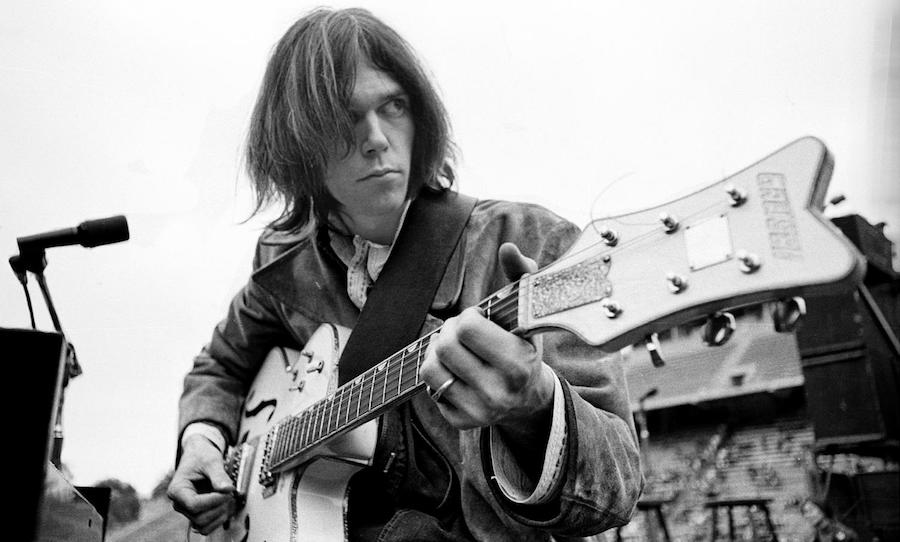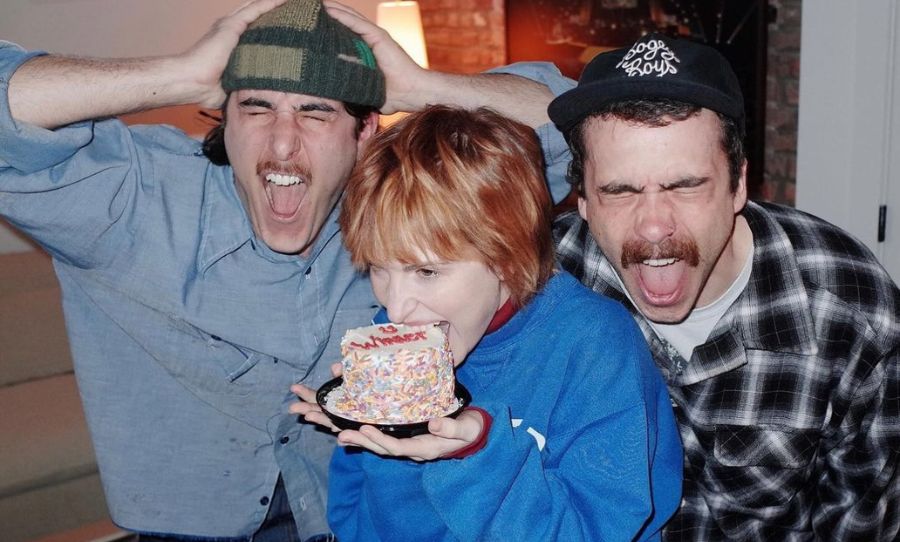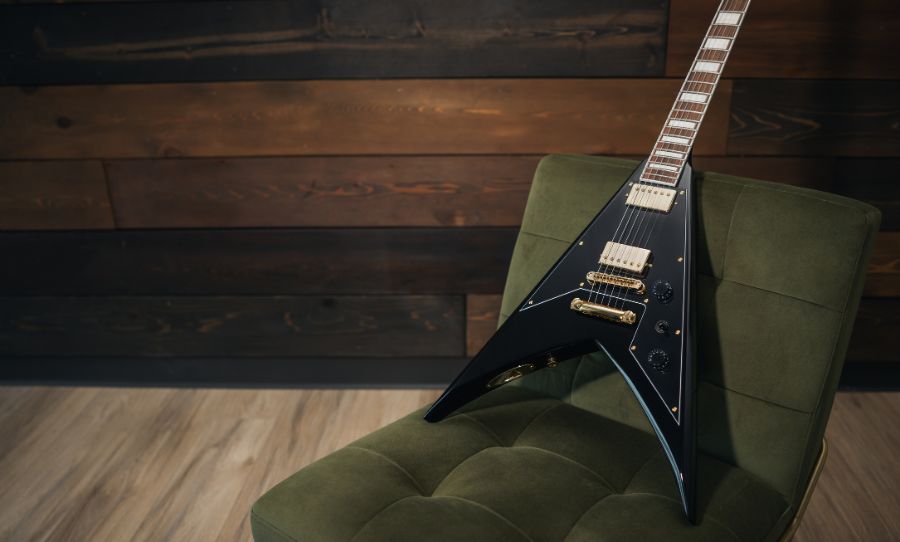If it wasn’t for the Gretsch White Falcon’s drop-dead good looks, it may have never ended up in the hands of rock’s greatest guitarists.
It’s arguably one of the prettiest instruments in the guitar world, if not the whole music world.
But for a guitar that has become a legend in the hands of many of the music world’s greatest performers, the Gretsch White Falcon almost fell out of the sky before it had a chance to soar.
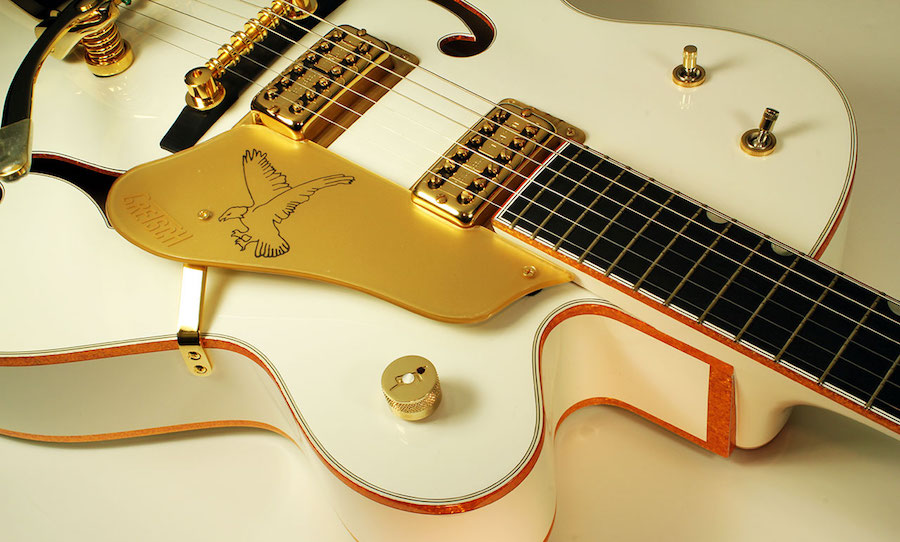
The Bird that Stopped the Show
Jimmie Webster was Gretsch’s main guitar design guru in the 1950s. He was a big car fan and was always keeping an eye out for the latest releases from Detroit. Webster’s designs often took cues from show-cars, and at the 1954 NAMM show, he went a step further, by releasing a guitar based around the idea of a concept car, a show exclusive prototype called ‘The White Falcon’.
It was a no-compromises, Rolls Royce of the guitar world, Webster claiming it was the guitar of the future. He even showcased the sparkly gold and white concept on a rotating display, as if it were a fancy automobile reveal.
The White Falcon stunned the crowds as the spotlights glimmered over its 24-karat gold finishes and gold sparkle bindings from Gretsch’s drum branch. With two DeArmond DynaSonic pickups, a winged headstock and inlaid feathers (to suit the falcon motif), it stole the show.
Simply put the public was smitten, but the fancy Gretsch was never made to be produced commercially, it was very labour intensive to build and too costly for the average joe. However, with all the preorders that were received by music dealers, Webster and Fred Gretsch Jr. simply had to find a way to build the White Falcon in their Brooklyn factory.
Flight of the Falcon
When the White Falcon was finally released in 1955 it retailed for $600US, which adjusting for inflation would place it near the $6000 mark had it been released in 2018. It was the second most expensive guitar money could buy, beat only by the Gibson Super 400CESN.
Throughout the 1950s and 1960s, Gretsch added numerous tweaks and upgrades to the White Falcon. The original single-coil DeArmond Dynasonic pickups were swapped for Filter’Tron humbuckers in 1958. In the same year, a Space Control bridge replaced the old Melita bridge. 1962 saw a new twin cutaway model, as well as the huge shiny gold Bigsby vibrato which became standard.
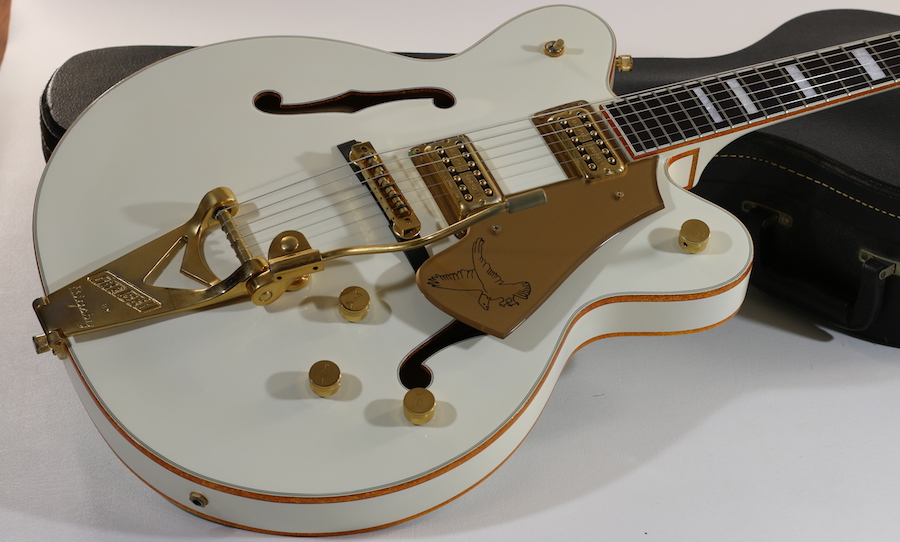
The White Falcon had no trouble picking up fans in the rockabilly and blues scene, however, as the 60’s rolled around, Gretsch, now run by the piano company Baldwin, struggled to keep up with popular rock and roll.
Stratocasters and Les Pauls began to rule the scene and as the decade progressed most artists became less interested in hollow body guitars. At the end of the 1960s, popular music was beginning to get heavy, which didn’t particularly suit a shiny Rolls Royce with strings.
To make matters worse, Baldwin moved production to Arkansas and Gretsch suffered through two disastrous fires. The Baldwin marriage was riddled with trouble and eventually resulted in a shutdown in production in the early-80s.
Legacy
Despite Gretsches’ troubles, the White Falcon hasn’t flown without its fans. One artist who has become synonymous with the White Falcon is Neil Young, who often used the guitar instead of his ‘Old Black’ Les Paul. Young had used Gretsches during his days with Buffalo Springfield, starting off with a 1959 6120 Chet Atkins Hollow Body, however, later, while playing with Crosby, Stills, Nash & Young, he picked up a single cut White Falcon in a trade with Steven Stills.
The guitar often featured where young needed a little more crunch in his tone, which can be heard on the 1970 Crosby, Stills, Nash & Young song Ohio and throughout 1972’s Harvest. Young went on to buy numerous White Falcon models, touring with them live, one notable performance being the first Farm Aid in 1985.
Other artists who have used the White Falcon for at least a good stint, are Joe Strummer of The Clash, Steve Marriot of the Small Faces/Humble Pie, Matthiew Ashman of Bow Wow Wow, Brain Jones of the Rolling Stones, Billy Duffy of The Cult, Brian Setzer of the Stray Cats and John Frusciante of the Red Hot Chilli Peppers.
 Perhaps because of its price and its exclusivity, the Gretch White Falcon didn’t quite achieve the same fame and success of other guitars, or other Gretsch’s for that matter. For this reason, it never quite caught on as a widely-known artist favourite, however, it has remained in the hearts of a select few musicians, as something of a special treat – kind of like a weekend cruise in a Rolls Royce.
Perhaps because of its price and its exclusivity, the Gretch White Falcon didn’t quite achieve the same fame and success of other guitars, or other Gretsch’s for that matter. For this reason, it never quite caught on as a widely-known artist favourite, however, it has remained in the hearts of a select few musicians, as something of a special treat – kind of like a weekend cruise in a Rolls Royce.
